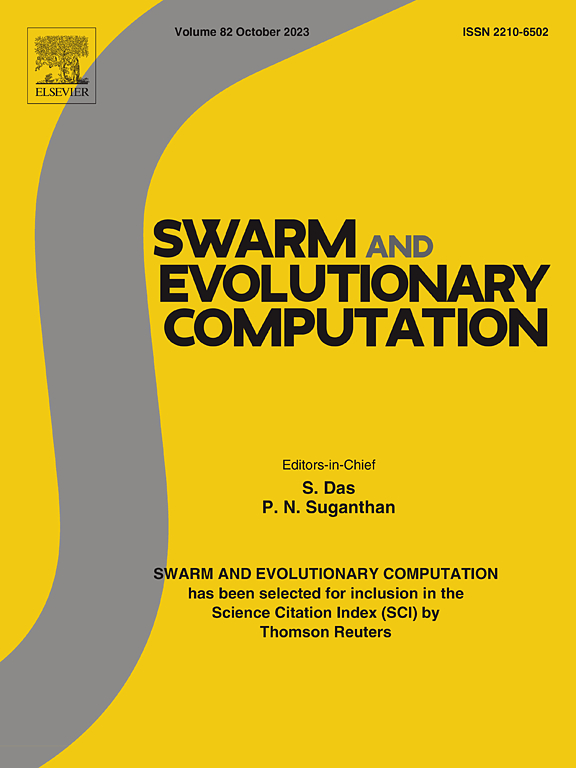Front guided surrogate-assisted evolutionary algorithm with adaptive selection of three-branch infill criteria for expensive many-objective optimization
IF 8.2
1区 计算机科学
Q1 COMPUTER SCIENCE, ARTIFICIAL INTELLIGENCE
引用次数: 0
Abstract
Expensive optimization problems are those where a single function evaluation takes a large amount of time, and are typically only allowed for a finite number of function evaluations. Thus, algorithms are extremely limited in the computational resources, and need to balance their ability of promoting convergence with of maintaining diversity. Especially when coping with many-objective optimization problems where the conflict between the two demands is further exacerbated, adaptive strategies that can promptly adjust computational resources according to the state of the population are of particular importance. To effectively solve expensive many-objective optimization problems with different characteristics, we propose a front guided surrogate-assisted evolutionary algorithm with adaptive selection of three-branch infill criteria (FGSAEA). FGSAEA consists of the front guided adaptive selection strategy and three infill criteria, all of which are featured by the positional relationship between the front of the candidate population and the archive storing truly evaluated solutions. FGSAEA uses the front guided adaptive selection strategy to determine the evolutionary state. To reduce the interference from inaccurate predictions of surrogate models, the strategy always takes the front of an archive storing all evaluated solutions as a reference. Then, FGSAEA utilizes one of three infill criteria respectively focused on promoting the convergence, the diversity of population, or the accuracy of surrogate models according to the demands. Experiments on benchmark problems demonstrate that FGSAEA is very competitive compared to state-of-the-art surrogate-assisted expensive many-objective optimization algorithms.
基于自适应选择三分支填充准则的前沿引导代理辅助进化算法用于昂贵的多目标优化
昂贵的优化问题是那些单个函数计算需要花费大量时间,并且通常只允许有限数量的函数计算的问题。因此,算法的计算资源极为有限,需要平衡促进收敛的能力和保持多样性的能力。特别是在处理多目标优化问题时,当两种需求之间的冲突进一步加剧时,能够根据种群状态及时调整计算资源的自适应策略就显得尤为重要。为了有效地解决具有不同特征的昂贵多目标优化问题,提出了一种具有自适应选择三分支填充准则的前制导代理辅助进化算法(FGSAEA)。FGSAEA由正面引导的自适应选择策略和三个填充准则组成,它们的特征都是候选种群的正面与存储真实评估解的存档之间的位置关系。FGSAEA采用前导自适应选择策略来确定进化状态。为了减少代理模型的不准确预测的干扰,该策略总是将存储所有评估解决方案的存档的前端作为参考。然后,FGSAEA根据需求使用三种填充标准中的一种,分别侧重于促进收敛性,人口多样性或代理模型的准确性。基准问题的实验表明,FGSAEA与最先进的代理辅助昂贵的多目标优化算法相比具有很强的竞争力。
本文章由计算机程序翻译,如有差异,请以英文原文为准。
求助全文
约1分钟内获得全文
求助全文
来源期刊

Swarm and Evolutionary Computation
COMPUTER SCIENCE, ARTIFICIAL INTELLIGENCEC-COMPUTER SCIENCE, THEORY & METHODS
CiteScore
16.00
自引率
12.00%
发文量
169
期刊介绍:
Swarm and Evolutionary Computation is a pioneering peer-reviewed journal focused on the latest research and advancements in nature-inspired intelligent computation using swarm and evolutionary algorithms. It covers theoretical, experimental, and practical aspects of these paradigms and their hybrids, promoting interdisciplinary research. The journal prioritizes the publication of high-quality, original articles that push the boundaries of evolutionary computation and swarm intelligence. Additionally, it welcomes survey papers on current topics and novel applications. Topics of interest include but are not limited to: Genetic Algorithms, and Genetic Programming, Evolution Strategies, and Evolutionary Programming, Differential Evolution, Artificial Immune Systems, Particle Swarms, Ant Colony, Bacterial Foraging, Artificial Bees, Fireflies Algorithm, Harmony Search, Artificial Life, Digital Organisms, Estimation of Distribution Algorithms, Stochastic Diffusion Search, Quantum Computing, Nano Computing, Membrane Computing, Human-centric Computing, Hybridization of Algorithms, Memetic Computing, Autonomic Computing, Self-organizing systems, Combinatorial, Discrete, Binary, Constrained, Multi-objective, Multi-modal, Dynamic, and Large-scale Optimization.
 求助内容:
求助内容: 应助结果提醒方式:
应助结果提醒方式:


